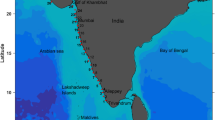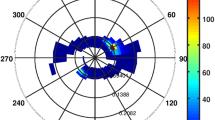Abstract
Directional wave measurements have been made in Liverpool Bay by means of wave buoys and acoustic instruments within the footprint of a phased-array high frequency (HF) radar system, which measures currents and waves. Several years of data have now been collected and are supplemented by an 11-year wave model hindcast. Wave parameters have been derived from the various instruments and compared: the directional waverider buoy is taken to provide the ground truth, confirming the good observations obtained from the ADCP; the HF radar wave data have a positive bias, while the model data have a negative bias. The variation of wave climate over various time-scales from seasonal and inter-annual to inter-decadal is examined. Significant wave–current interactions may occur in this area of shallow water and high tidal range and the measurements provide a good test of coupled hydrodynamic-wave models. The waves are mainly fetch-limited: largest events are due to depressions, which track across the UK from SW, generating westerly and WNW winds in the right rear quadrant. Hence, the future extreme wave events will be closely related to future North Atlantic storm tracks. Projections of 50-year return period wave heights differ between different instruments and model datasets. The future wave climate of Liverpool Bay is not expected to change much from the present day; although a slight increase in the severity of the most extreme events is projected, the frequency of extreme wind and wave events in general is slightly reduced. There is evidence for variability on decadal time-scales, with some correlation with the North Atlantic oscillation.
















Similar content being viewed by others
References
Bacon S, Carter DJT (1991) Wave climate changes in the North Atlantic and North Sea. Int J Climatol 11:545–558
Battjes JA (1972) Long-term wave height distributions at seven stations around the British Isles. Ocean Dynam 25(4):179–189
Bell PS (2008) Mapping of bathymetry and tidal currents in the Dee Estuary using marine radar data. Proc PECS 2008: Physics of Estuaries and Coastal Seas, 25–29 August 2008, Liverpool, (UK) pp. 175–178
Brown JM (2010) A case study of combined wave and water levels under storm conditions using WAM and SWAN in a shallow water application. Ocean Model 35(3):215–229. doi:10.1016/j.ocemod.2010.07.009
Brown JM, Souza AJ, Wolf J (2009) An investigation of recent decadal-scale storm events in the eastern Irish Sea. J Geophys Res Oceans. doi:10.1029/2009JC005662, Vol. 115
Brown JM, Souza AJ, Wolf J (2010) An 11-year validation of wave-surge modelling in the Irish Sea, using a nested POLCOMS-WAM modelling system. Ocean Model 33(1–2):118–128. doi:10.1016/j.ocemod.2009.12.006
Brown JM, Bolaños R, Wolf J (2011a) A shallow water comparison of radiation stress implemented in 2D and 3D during an extreme storm using a tide-surge-wave modelling system. Submitted to Coastal Engineering
Brown JM, Wolf J, Souza AJ (2011b) Future extreme events in Liverpool Bay: model projections from 1960–2100. Submitted to Climatic Change
Caires S, Sterl A (2005) 100-year return value estimates for ocean wind speed and significant wave height from the ERA-40 data. J Climate 18(7):1032–1048
Carter DJT, Draper L (1988) Has the Northeast Atlantic become rougher? Nature 332:494
Draper L, Blakey A (1969) Waves at the Mersey Bar Light Vessel. National Institute of Oceanography Internal Report no. A37
Gurgel K-W, Antonischki G, Essen H-H, Schlick T (1999) Wellen Radar (WERA): a new ground-wave HF radar for ocean remote sensing. Coast Eng 37:219–234
Hawkes PJ, Atkins R, Brampton AH, Fortune D, Garbett R, Gouldby BP (2001) WAVENET: Nearshore wave recording network for England and Wales: Feasibility Study, HR Wallingford Report TR 122, 106 pp
Hedges TS, Burrows R, Dickinson PJ (1991) Coastal wave climate categorization using wind data. Proc Inst Civ Eng Part 2 91(4):631–644
Helzel T, Kniephoff M, Petersen L (2006) WERA: remote ocean sensing for current, wave and wind direction, Proc US/EU-Baltic Int Symposium, 23–25 May, 2006. Klaipeda, Lithuania, IEEE, p 8
Holt JT, James ID (2001) An s coordinate density evolving model of the northwest European continental shelf 1, model description and density structure. J Geophys Res 106:14015–14034
Howarth MJ, Proctor R, Knight PJ, Smithson MJ, Mills DK (2006) The Liverpool Bay Coastal Observatory–towards the goals. Proc Oceans 2006, 18–21 September 2006, Boston, IEEE, 6pp
Howarth MJ, Player RJ, Wolf J, Siddons LA (2007) HF radar measurements in Liverpool Bay, Irish Sea. Proc Oceans '07 IEEE Aberdeen: Marine challenges: coastline to deep sea. Aberdeen, Scotland: IEEE, 6 pp
Hurdle DP, Stive RJH (1989) Revision of SPM 1984 wave hindcast model to avoid inconsistencies in engineering applications. Coast Eng 12:339–351
Krogstad HE, Wolf J, Thompson SP, Wyatt L (1999) Methods for intercomparison of wave measurements. Coast eng 37(3–4):235–257
Lamb HH (1995) Climate, History and the Modern World. 464 pp
Lane A (2008) A 3-D numerical model of Liverpool Bay for the coastal observatory. Proc PECS 2008: Physics of Estuaries and Coastal Seas, Liverpool, UK, 25th–29th August 2008. Liverpool, 415–418
Lowe JA, Howard T, Pardaens A, Tinker J, Holt J, Wakelin S, Milne G, Leake J, Wolf J, Horsburgh K, Reeder T, Jenkins G, Ridley J, Dye S, Bradley S (2009) UK climate projections science report: marine and coastal projections. Met Office Hadley Centre, Exeter, UK
Mastenbroek C, Burgers G, Janssen PAEM (1993) The dynamical coupling of a wave model and a storm surge model through the atmospheric boundary layer. J Phys Oceanogr 23(8):1856–1866
Mellor GL (2003) The three-dimensional current and surface wave equations. J Phys Oceanogr 33(9):1978–1989
Mellor GL (2005) Some consequences of the three-dimensional current and surface wave equations. J Phys Oceanogr 35(11):2291–2298
Mellor GL (2008) The depth-dependent current and wave interaction equations: a revision. J Phys Oceanogr 38:2587–2596
Osuna P, Wolf J (2005) (2005) A numerical study on the effect of wave-current interaction process in the hydrodynamics of the Irish Sea, Proc WAVES 2005. Madrid, July
Pan S, Chen Y, Wolf J, Du Y (2009) Modelling of waves in the Irish Sea: effects of oceanic wave and wind forcing. Ocean Dynam 59(6):827–836
Tsimplis MN, Woolf DK, Osborn TJ, Wakelin S, Wolf J, Flather RA, Shaw AGP, Woodworth P, Challenor PG, Blackman D, Pert F, Yan Z (2005) Towards a vulnerability assessment of the UK and northern European coasts: the role of regional climate variability. Philos Trans R Soc A 363:1329–1358. doi:10.1098/rsta.2005.1571
Tucker MJ, Pitt EG (2001) Waves in Ocean Engineering, 521 pp. Elsevier
Uppala SM, Kållberg PW, Simmons AJ et al (2005) The ERA-40 re-analysis. Quart J R Meteorol Soc 131:2961–3012. doi:10.1256/qj.04.176
Wolf J (1998) Waves at Holderness: results from in-situ measurements. Proc Oceanology'98, Brighton, UK, March 1998, pp. 387–398
Wolf J (2003) Parametric Modelling of Waves in Liverpool Bay and Dee Estuary. POL Internal Document No. 162
Wolf J (2004) Coupling waves and currents in POLCOMS with measurements from the coastal observatory. Annal Hydrogr, 6th Ser., 3(772):9-1–9-3
Wolf J (2008) Coupled wave and surge modelling and implications for coastal flooding. Adv Geosci 17:19–22
Wolf J (2009) Coastal flooding—impacts of coupled wave–surge–tide models. Nat Hazards 49(2):241–260
Wolf J, Bell PS (2001) Waves at holderness from X-band radar. Coast Eng 43(3–4):247–263
Wolf J, Wakelin SL (2003) BNSC Earth Observation LINK Project R5/002, The Influences of Environmental Processes on Shallow Water Bathymetry, Technical Note 2: Wave-Current Modelling (WP 30): Phase 1. POL Internal Document No. 152
Wolf J, Woolf DK (2006) Waves and climate change in the north-east Atlantic. Geophys Res Lett 33:L06604. doi:10.1029/2005GL025113
Wolf J, Wakelin SL and Flather RA (2002) Effects of climate change on wave height at the coast. Proc Twelfth Int Offshore and Polar Engineering Conf, Kitakyushu, Japan, May 26–31, 2002, 3:135-142
Woolf D, Wolf J (2010) Storms and waves. MCCIP annual report card 2010–11, MCCIP Science Review, 15 pp. www.mccip.org.uk/arc
Woolf DK, Challenor PG, Cotton PD (2002) Variability and predictability of the North Atlantic wave climate. J Geophys Res 107:3145
Woolf DK, Cotton PD, Challenor PG (2003) Measurements of the offshore wave climate around the British Isles by satellite altimeter. Philos Transact A Math Phys Eng Sci 361(2003):27–31. doi:10.1098/rsta.2002.1103
Wyatt LR (2000) Limits to the inversion of HF radar backscatter for ocean wave measurement. J Atmos Ocean Tech 17:1651–1666
Acknowledgements
Part of this research was funded by the NERC–FREE CoFEE (grant NE/E002471/1) and the EU FP7 MICORE (grant 202798) projects. Some of the wave buoy data were obtained from the Centre for Environment Fisheries and Aquaculture Science (CEFAS) WaveNet system (http://www.cefas.co.uk/our-science/observing-and-modelling/monitoring-programmes/wavenet.aspx). We are grateful to RWE npower renewables for provision of the wind data from Gwynt y Môr. Thanks also to Tim Osborn and Phil Jones of the UEA CRU for providing NAO index data on their web site: http://www.cru.uea.ac.uk/∼timo/datapages/naoi.htm.
Author information
Authors and Affiliations
Corresponding author
Additional information
Responsible Editor: Claire Mahaffey
This article is part of the Topical Collection on the UK National Oceanography Centre's Irish Sea Coastal Observatory
Rights and permissions
About this article
Cite this article
Wolf, J., Brown, J.M. & Howarth, M.J. The wave climate of Liverpool Bay—observations and modelling. Ocean Dynamics 61, 639–655 (2011). https://doi.org/10.1007/s10236-011-0376-9
Received:
Accepted:
Published:
Issue Date:
DOI: https://doi.org/10.1007/s10236-011-0376-9




